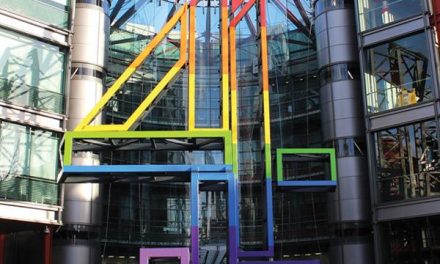In analysing media in 21st century, we have becomes used to thinking about working relationships which have become virtual. In an ideal world, creators, practitioners and viewers can ignore the constrictions of place and produce work together in the click of an upload. But broadcasters still have buildings, offices, studios, sets and workspaces. This is particularly the case with the BBC which has recently massively revamped Broadcasting House and pulled television into its (dark) heart. So it may be worth thinking about how physical structures still have an impact on what and how things get made and how broadcasting offices constrain or encourage creative relationships.
A recent event organised by the Royal Television Society, London, got me thinking about buildings. The session entitled ‘Emptying the Centre’ pulled in a large audience and a show of hands showed that about 90% of them had worked in the Centre under discussion, the BBC Television Centre (TVC) at White City about 4 miles west of Central London. It was officially opened in 1960 and from then on was the headquarters of BBC Television until its closure in March 2013. It had been announced in 2007 that the BBC intended to reduce its property portfolio in west London and by July 2012 the complex had been sold to property developers Stanhope plc. although, as our speakers made clear, the BBC is still a partner in developing the site.
The panel for the event consisted of Adrian Poole, Director of IT and Technology Delivery, BBC; Andrew Wheeler, Decommissioning Lead, TVC Technology Programme, BBC; and Chris Kane, CEO, BBC Commercial Projects. It seemed at first that they might have a hard time with an audience which had come to mourn the loss of their workplace and express anger about its demise. But it was clear that the speakers knew something of what the audience felt. Adrian Poole spoke of a ‘building which had a heartbeat for the people who worked there’ while Chris Kane described it as ‘one of the great buildings in the world’ and remarked that he had ‘never seen a building where so many people were attached to a piece of real estate’.



Legend has it that the initial design had been drawn on the back of an envelope by architect Graham Dawbarn. There were sighs of nostalgia as pictures of the complex went up on screen, with the familiar question mark which shaped the design showing up clearly in the aerial shots. There seemed to be something very pleasing about public service broadcasting being produced under the sign of a question mark.


All the speakers gave accounts of how the building was no longer fit for purpose. The BBC had been investing in real estate out in the regions and nations (BBC Scotland at Pacific Quay, MediaCityUK at Salford and the BBC Cymru Wales drama studios at Roath Lock, Cardiff Bay) and so had no need for the full range of studios and offices at this site. But the speakers also sought to demonstrate that the accretions of analogue broadcasting could no longer be nursed into new life and the BBC could no longer trust the beating heart of TVC to securely deliver its 24 hour digital services.
Although Poole and Kane were charged with leading the audience to accept the new future for the site, in many ways it was Andrew Wheeler who provided the most dramatic and persuasive account. His job was literally to turn everything off and get it all out, a job made more difficult because it would seem no cable, no desk, no satellite dish had actually been discarded; new equipment just got added. In all workplaces, the accumulation of objects gets overlooked but in the context of broadcasting’s connections with modernity the banality of old studio clocks, archaic camara tubes and ancient telephones seemed the more poignant. An audience of old techies gasped at a picture of a clump of cables, as thick as an oak’s tree trunk, and could well understand the difficulty of tracking down the long-overlooked purpose of each one. So far the only problem that had arisen from pulling out the cables had been the temporary loss of sub-titling in Tunbridge Wells. ’It would be Tunbridge Wells’ muttered someone in the audience who seemed to have had past experience of complaints from a far-from-apocryphal ‘Disgusted from Tunbridge Wells’.
This emphasis on the physical building and the feelings it aroused took me back to Tom Burn’s classic book The BBC Public Institution and Private World, a remarkable and inspirational account of the BBC in the 1960s and ‘70s. He pointed to the contrast between Broadcasting House in central London and the TVC ‘in a district which derived its strongest flavour from exhibitions, dog racing, and the film industry’ (Shepherds Bush is still a bit raffish even though its biggest attraction is now a Westfield Shopping Centre). And he noted that ‘the different balance between central authority and organisation structure on the one hand and programme-centred activities on the other is demonstrated by the reversal of basic design in the two buildings – the sound studies enclosed by the carapace of offices at Broadcasting House, and the eruption of studios, design shops and engineering sections outwards from the hollow, office-ringed, drum in the middle of Television Centre’ (79).


Burns noted that many people he spoke to, including those who had worked there from the beginning, ‘confess to losing their way in the building, the circulation space of which is designed on the simplest of plans’. (81) That was a shared joke at the RTS meeting and perhaps the love of this workplace owed something to the sense that a building built around a common purpose also allowed for detours and serendipity. You could be friendly and sociable there but you could hide away in a hidden corner to work on an idea or bump into something unexpected round the corner. You could feel that you were away from the concerns of central authority and concentrate on untangling the cables and getting the programme out.
The physical building allowed for physical relationships and it is impossible not to be aware that Jimmy Savile thrived at TVC. But it’s important not to let that wipe out the connections that could be creatively made there. As someone who’d worked there commented on a BBC website when the building shut down: ‘Television Centre was built as a custom built broadcast environment full of expertise, where if you had a problem you could simply walk round to where the issue was’. That simple act of walking feels like a creative action.
Chris Kane spoke about the future of the site which will still have a BBC presence through BBC Worldwide and Postproduction and there will be three studios available for hire. There will also be residential development including a highrise block of flats and an Imperial College campus. I do hope that there are PhD students somewhere studying the changes and following Tom Burn’s example by exploring the staff’s interaction with and feelings about their new surroundings.


Further information
Tom Burns The BBC Public Institution and Private World. The Macmillan Press Ltd, London, 1977
There is a mass of material on line including lots of splendid photographs but here are some I enjoyed.
Phil Coomes, Picture Editor at the BBC http://www.bbc.co.uk/news/in-pictures-18627051
The BBC’s version at BBC Buildings www.bbc.co.uk/historyofthebbc/…/buildings/television_centre.shtm
And this is a link to an item for Panorama which told viewers in 1956 about the new building http://www.bbc.co.uk/panorama/hi/front_page/newsid_8762000/8762400.stm
www.tvstudiohistory.co.uk includes ‘An unreliable and wholly unofficial history of BBC Television Centre’ with ‘grateful thanks to several current and ex BBC staffers who have passed some fascinating documents and other information to me.’
And of course there are now tours of BBC buildings in a move which combines concerns about transparency for the taxpayer and the BBC status as a psb broadcaster/cultural heritage holder.
Christine Geraghty is an Honorary Professorial Fellow at the University of Glasgow and an Honorary Research Fellow at Goldsmiths, University of London. Her latest publication is an essay on ‘The BFI women and film study group 1976 – ?’ (in Renewing Feminisms, Helen Thornham and Elke Weissmann (eds.), I.B.Tauris, 2013) which recalls the group’s work on Coronation Street and led to her book, Women and Soap Opera (Polity, 1991). Her BFI TV Classic on Bleak House (2005) was published in October 2012. She is on the editorial board of the Journal of British Cinema and Television and sits on the advisory boards of a number of journals, including Screen.





